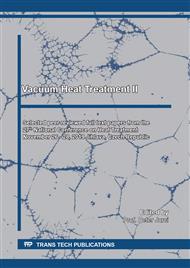p.1
p.11
p.19
p.37
p.47
p.57
p.67
p.75
p.91
Fe-Me-B Diffusion Layers for Surface Modification of Carbon Steels
Abstract:
Multicomponent boron-based diffusion layers are capable to provide a wider variety of surface improvements compared to pure boriding. In this research, we consider a way to increase mechanical properties of carbon steels by using two-component thermal-chemical treatment (TCT) such as boroaluminizing (B+Al), and boronickelizing (B+Ni). Diffusion treatment of steel surface was carried out by pack method in powder mixtures, and pastes, containing the above-mentioned elements and sodium fluoride as an activator. The exposure time was 3 hours, the treatment temperature was 950 °C. Pure boriding was conducted additionally to compare with two-component methods. The metallographic analysis revealed diffusion layers with a tooth-like structure after boriding and B+Ni. Typical composition of boride layer with iron boride FeB as an outer phase and Fe2B as an inner one was obtained after the first method. EDS analysis revealed a small amount of Ni (less than 1%) in boronickelized layer. Although XRD analysis revealed Ni2B, Fe3Ni3B besides iron borides and carboborides after B+Ni. Another structure was obtained after B+Al – namely a layered microstructure with outer softer iron aluminides and iron borides beneath. The thickest layer was obtained after boriding with the thickness of 140-160 μm, where higher value corresponds to low-carbon steel and vice versa. While for boroaluminizing the layer thickness was around 120-140 μm and for boronickelizing - 60-100 μm. Microhardness profiles differ significantly depending on the TCT method. For instance, initial high values followed by a drastic drop of hardness for boriding and boronickelizing. Wave type profiles characterize the microhardness distribution on boroaluminized samples. Wear tests indicated that samples with boride layer were the most wear resistant and the least resistant were the samples after B+Al. Fe-Me-B layers with the tooth-like structure are superior to the ones with the layered structure.
Info:
Periodical:
Pages:
47-56
Citation:
Online since:
September 2020
Price:
Сopyright:
© 2020 Trans Tech Publications Ltd. All Rights Reserved
Share:
Citation:


